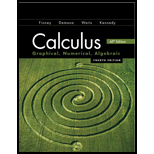
(a)
Whether h is a twice-differentiable function of x.
(a)
Answer to Problem 75E
The statement is true.
Explanation of Solution
Given information:
Where,
f has a negative derivative for all values of x and that
According to FTC (Fundamental Theorem of Calculus),
Then
Taking derivative again
According to the statement,
f has negative derivative for all values of x.
That means
Then
Therefore,
h is a twice differentiable function of x.
(b)
Whether h and
(b)
Answer to Problem 75E
The statement is true.
Explanation of Solution
Given information:
Where,
f has a negative derivative for all values of x and that
According to FTC (Fundamental Theorem of Calculus),
Then
Taking derivative again
Thus,
We have
Both
Therefore,
They both are continuous.
(c)
Whether the graph of h has a horizontal tangent at
(c)
Answer to Problem 75E
The statement is true.
Explanation of Solution
Given information:
Where,
f has a negative derivative for all values of x and that
If
h has a horizontal tangent at
Since
Then
According to the statement,
Therefore,
(d)
Whether h has
(d)
Answer to Problem 75E
The statement is true by the Second Derivative Test.
Explanation of Solution
Given information:
Where,
f has a negative derivative for all values of x and that
If
And
Then
h has a local maximum at
According to Part (c) result,
We have
Since
Then
According to the statement,
f has negative derivative for all values of x.
That means
Therefore,
(e)
Whether h has
(e)
Answer to Problem 75E
The statement is false by the Second Derivative Test.
Explanation of Solution
Given information:
Where,
f has a negative derivative for all values of x and that
If
And
Then
h has a local minimum at
According to Part (a) result,
We have
And
Then
And
According to statement,
Thus,
We also have
Thus,
Therefore,
h does not have a local minimum at
(f)
Whether the graph of h has an inflection point at
(f)
Answer to Problem 75E
The statement is false.
Explanation of Solution
Given information:
Where,
f has a negative derivative for all values of x and that
If
Then
h has an inflection point at
According to Part (a) result,
We have
And
Then
And
We also have
Thus,
Therefore,
h does not have an inflection point at
(g)
Whether the graph
(g)
Answer to Problem 75E
The statement is true.
Explanation of Solution
Given information:
Where,
f has a negative derivative for all values of x and that
We have
According to the statement,
f is a decreasing function.
That includes
Point (1, 0) because
Then
Therefore,
Chapter 6 Solutions
Calculus 2012 Student Edition (by Finney/Demana/Waits/Kennedy)
Additional Math Textbook Solutions
Thinking Mathematically (6th Edition)
Calculus: Early Transcendentals (2nd Edition)
Calculus: Early Transcendentals (2nd Edition)
College Algebra (7th Edition)
- For each graph in Figure 16, determine whether f (1) is larger or smaller than the slope of the secant line between x = 1 and x = 1 + h for h > 0. Explain your reasoningarrow_forwardPoints z1 and z2 are shown on the graph.z1 is at (4 real,6 imaginary), z2 is at (-5 real, 2 imaginary)Part A: Identify the points in standard form and find the distance between them.Part B: Give the complex conjugate of z2 and explain how to find it geometrically.Part C: Find z2 − z1 geometrically and explain your steps.arrow_forwardA polar curve is represented by the equation r1 = 7 + 4cos θ.Part A: What type of limaçon is this curve? Justify your answer using the constants in the equation.Part B: Is the curve symmetrical to the polar axis or the line θ = pi/2 Justify your answer algebraically.Part C: What are the two main differences between the graphs of r1 = 7 + 4cos θ and r2 = 4 + 4cos θ?arrow_forward
- A curve, described by x2 + y2 + 8x = 0, has a point A at (−4, 4) on the curve.Part A: What are the polar coordinates of A? Give an exact answer.Part B: What is the polar form of the equation? What type of polar curve is this?Part C: What is the directed distance when Ø = 5pi/6 Give an exact answer.arrow_forwardNew folder 10. Find the area enclosed by the loop of the curve (1- t², t-t³)arrow_forward1. Graph and find the corresponding Cartesian equation for: t X== y = t +1 2 te(-∞, ∞) 42,369 I APR 27 F5 3 MacBook Air stv A Aa T 4 DIIarrow_forward
- Middle School GP... Echo home (1) Addition and su... Google Docs Netflix Netflix New folder 9. Find the area enclosed by x = sin²t, y = cost and the y-axis.arrow_forward2. Graph and find the corresponding Cartesian equation for: (4 cos 0,9 sin 0) θ ε [0, 2π) 42,369 I APR 27 3 MacBook Air 2 tv A Aaarrow_forward30 Page< 3. Find the equation of the tangent line for x = 1+12, y = 1-3 at t = 2 42,369 APR A 27 M . tv NA 1 TAGN 2 Aa 7 MacBook Air #8arrow_forward
 Calculus: Early TranscendentalsCalculusISBN:9781285741550Author:James StewartPublisher:Cengage Learning
Calculus: Early TranscendentalsCalculusISBN:9781285741550Author:James StewartPublisher:Cengage Learning Thomas' Calculus (14th Edition)CalculusISBN:9780134438986Author:Joel R. Hass, Christopher E. Heil, Maurice D. WeirPublisher:PEARSON
Thomas' Calculus (14th Edition)CalculusISBN:9780134438986Author:Joel R. Hass, Christopher E. Heil, Maurice D. WeirPublisher:PEARSON Calculus: Early Transcendentals (3rd Edition)CalculusISBN:9780134763644Author:William L. Briggs, Lyle Cochran, Bernard Gillett, Eric SchulzPublisher:PEARSON
Calculus: Early Transcendentals (3rd Edition)CalculusISBN:9780134763644Author:William L. Briggs, Lyle Cochran, Bernard Gillett, Eric SchulzPublisher:PEARSON Calculus: Early TranscendentalsCalculusISBN:9781319050740Author:Jon Rogawski, Colin Adams, Robert FranzosaPublisher:W. H. Freeman
Calculus: Early TranscendentalsCalculusISBN:9781319050740Author:Jon Rogawski, Colin Adams, Robert FranzosaPublisher:W. H. Freeman
 Calculus: Early Transcendental FunctionsCalculusISBN:9781337552516Author:Ron Larson, Bruce H. EdwardsPublisher:Cengage Learning
Calculus: Early Transcendental FunctionsCalculusISBN:9781337552516Author:Ron Larson, Bruce H. EdwardsPublisher:Cengage Learning





